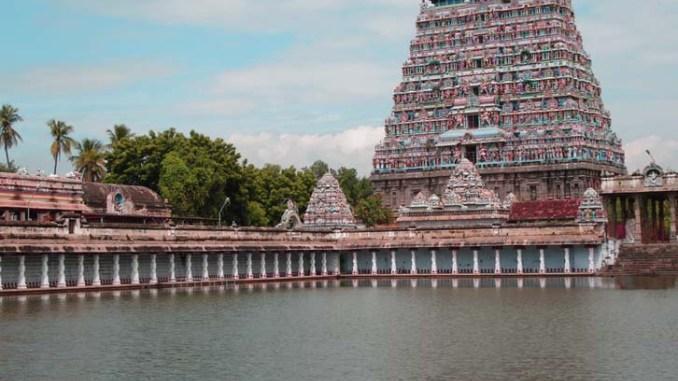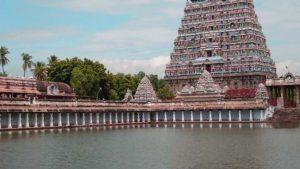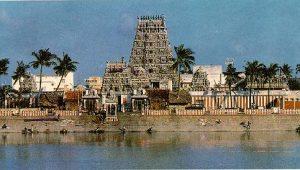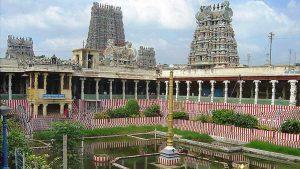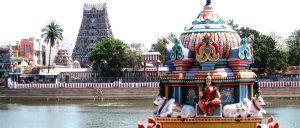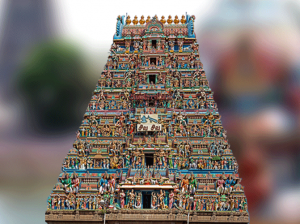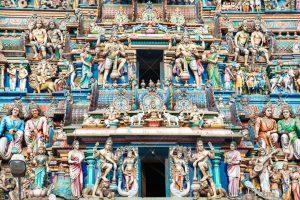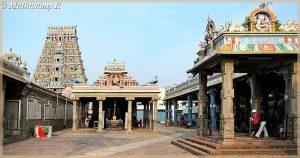Kapaleeshwarar Temple, Chennai, Tamil Nadu
| Date built: | – |
|---|---|
| Deity: | – |
| Architectural style: | Dravidian architecture |
| Major festivals | – |
| Locale: | Mylapore |
| District:: | Chennai |
| Address: | Kapaleesvarar Sannadhi Street, Vinayaka Nagar Colony, Mylapore, Chennai, Tamil Nadu 600004 |
| Phone | 04424641670 |
Kapaleeshwarar Temple is a Hindu temple dedicated to lord Shiva located in Mylapore, Chennai in the Indian state of Tamil Nadu. The form of Shiva’s consort Parvati worshipped at this temple is called Karpagambal is from Tamil (“Goddess of the Wish-Yielding Tree”). The temple is the most ancient one that has been built around the 7th century CE in Dravidian architecture.
According to the Puranas, Shakti worshipped Shiva in the form of a peacock, giving the vernacular name Mylai (Mayilāi) to the area that developed around the temple – mayil is Tamil for “peacock”.Shiva is worshiped as Kapaleeswarar, and is represented by the lingam. His consort Parvati is depicted as Karpagambal. The presiding deity is revered in the 7th century Tamil Saiva canonical work, the Tevaram, written by Tamil saint poets known as the Nayanars and classified as Paadal Petra Sthalam.
The temple has numerous shrines, with those of Kapaleeswarar and Karpagambal being the most prominent. The temple complex houses many halls. The temple has six daily rituals at various times from 5:30 a.m. to 10 p.m., and four yearly festivals on its calendar. The Arubathimooval festival celebrated during the Tamil month of Panguni is the most prominent festival in the temple.
The present masonry structure was built during the Vijayanagar rulers of the Tuluva Dynasty (1491–1570 CE). The temple is maintained and administered by the Hindu Religious and Endowment Board of the Government of Tamil Nadu.
Architecture
The Kapaleeshwarar temple is of typical Dravidian architectural style, with the gopuram overpowering the street on which the temple sits. This temple is also a testimonial for the vishwakarmas sthapathis. There are two entrances to the temple marked by the gopuram on either side. The east gopuram is about 40 m high, while the smaller western gopuram faces the sacred tank.
The vahanas (Sanskrit for “vehicles”) at the temple include the bull, Adhikaranandi, elephant, bandicoot, peacock, goat and parrot, while a golden chariot is a recent addition. Statues of the god and the goddess are seated on a vahana or chariot which is brought in a procession around the temple while the temple band plays music. Devotees gather around the vahanas and consider it a privilege to pull / lift the God and the Goddess on the vahana. There is also a peacock and a peahen caged inside the temple, to symbolize the tradition that Karpagambal had come in the form of peahen to plead to Kapaleeshwarar.
Legend / Local stories
The temple’s name is derived from the words kapalam (head) and eeshwarar an alias of lord Shiva. According to the Puranas, during the meeting of Brahma and Shiva at top of Mount Kailash Brahma failed to show the due respect to Shiva. Due to this, Shiva plucked of one of Brahma’s heads (kapalams). In an act of penance, Brahma came down to the site of Mylapore and installed a Lingam to please Shiva.This place is known as Sukra Puri, Veda Puri, among many other names including “Kailaye Mayilai and Mayilaye Kayilai “which means this place is equal to kailash. Goddess Karpagambal, a form of Shiva’s consort Parvati, due to a curse became a pea-hen and did penance here to get back her original personality. Shiva’s son Murugan received the spear (Sakthi Vel) for the destruction of a demon from Parvati here. Brahma had worshipped here to get rid of his ego and get back his power to create. The four Vedas have worshipped here. Sukracharya worshipped the Lord here and got back his lost eye. Rama has worshipped here and won the war against Ravana and brought back Sita from Lanka. The daughter of Sivanesa Chettiar Angam Poompavai got her lost life due to snake bite was later resurrected here by the powers of Thirugnana Sambandar. Vayilar Nayanar, a saiva saint, attained salvation here and Mylapore is also the birth place of Thiruvalluvar who wrote Thirukkural. In Thevaram special mention is made about the beautiful Madaveedhi as “Malgun Mathri Thavazhum Maada Veedhi Mylappil Ullar”. Thiruganana Sambandar, Arunagirinathar have sung the glory of Karpagambal, Singara Velar. The 10-day festival during March / April is a treat to watch and Arubathu Moovar festival is attended by lakhs of devotees every year.The commonly held view is that the temple was built in the 7th century CE by the ruling Pallavas.This view is based on references to the temple in the hymns of the Nayanars (which, however, place it by a sea shore). Thirugnanasambandar’s 6th song in Poompavaipathikam and Arunagirinathar’s 697th song in Thirumylai Thirupugazh, make clear reference to the Kapaleeswarar temple being located by a seashore.There are inscriptions dating back to 12th century inside the temple. The temple’s 120 ft gopuram (gateway tower) was built during 1906 with stucco figures adorning it. The temple is maintained and administered by the Hindu Religious and Endowment Board of the Government of Tamil Nadu.
Photo Gallery
How to Reach:
Contact Details
Official Address

